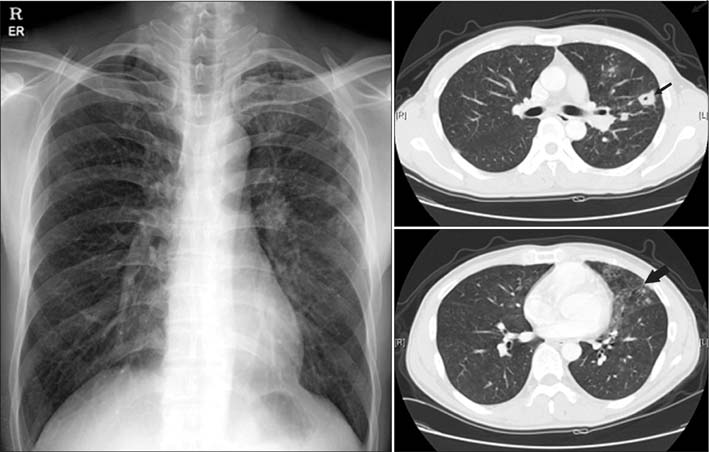Tuberc Respir Dis.
2014 Feb;76(2):84-87. 10.4046/trd.2014.76.2.84.
Pandemic Influenza (H1N1) and Mycobacterium tuberculosis Co-infection
- Affiliations
-
- 1Division of Infectious Diseases, Department of Internal Medicine, Yonsei University College of Medicine, Seoul, Korea. shhan74@yuhs.ac
- KMID: 1877346
- DOI: http://doi.org/10.4046/trd.2014.76.2.84
Abstract
- We hereby observe four co-infection cases of pandemic influenza H1N1 and Mycobacterium tuberculosis with various clinical presentations. It may be prudent to consider M. tuberculosis co-infections when patients with pandemic influenza reveal unusual clinical features that do not improve despite appropriate treatments against the influenza, especially in Korea, in the endemic areas of M. tuberculosis.
MeSH Terms
Figure
Reference
-
1. Centers for Disease Control and Prevention (CDC). Outbreak of swine-origin influenza A (H1N1) virus infection: Mexico, March-April 2009. MMWR Morb Mortal Wkly Rep. 2009; 58:467–470.2. Ellner JJ. Immunosuppression in tuberculosis. Infect Agents Dis. 1996; 5:62–72.3. Kantzler GB, Lauteria SF, Cusumano CL, Lee JD, Ganguly R, Waldman RH. Immunosuppression during influenza virus infection. Infect Immun. 1974; 10:996–1002.4. Lofgren S, Callans A. Asian influenza and pulmonary tuberculosis. Acta Med Scand. 1959; 164:523–527.5. Puvanalingam A, Rajendiran C, Sivasubramanian K, Ragunanthanan S, Suresh S, Gopalakrishnan S. Case series study of the clinical profile of H1N1 swine flu influenza. J Assoc Physicians India. 2011; 59:14–16. 186. Koegelenberg CF, Irusen EM, Cooper R, Diacon AH, Taljaard JJ, Mowlana A, et al. High mortality from respiratory failure secondary to swine-origin influenza A (H1N1) in South Africa. QJM. 2010; 103:319–325.7. Housworth J, Langmuir AD. Excess mortality from epidemic influenza, 1957-1966. Am J Epidemiol. 1974; 100:40–48.8. Archer B, Cohen C, Naidoo D, Thomas J, Makunga C, Blumberg L, et al. Interim report on pandemic H1N1 influenza virus infections in South Africa, April to October 2009: epidemiology and factors associated with fatal cases. Euro Surveill. 2009; 14:pii: 19369.9. World Health Organization. Global tuberculosis report 2012 [Internet]. Geneva: World Health Organization;2012. cited 2013 Oct 1. Available from: http://www.who.int/tb/publications/global_report/en/.10. Noh JY, Lee J, Choi WS, Song JY, Seo YB, Kim IS, et al. Concurrent tuberculosis and influenza, South Korea. Emerg Infect Dis. 2013; 19:165–167.11. Volkert M, Pierce C, Horsfall FL, Dubos RJ. The enhancing effect of concurrent infection with pneumotropic viruses on pulmonary tuberculosis in mice. J Exp Med. 1947; 86:203–214.12. Co DO, Hogan LH, Karman J, Heninger E, Vang S, Wells K, et al. Interactions between T cells responding to concurrent mycobacterial and influenza infections. J Immunol. 2006; 177:8456–8465.13. Jiang TJ, Zhang JY, Li WG, Xie YX, Zhang XW, Wang Y, et al. Preferential loss of Th17 cells is associated with CD4 T cell activation in patients with 2009 pandemic H1N1 swine-origin influenza A infection. Clin Immunol. 2010; 137:303–310.
- Full Text Links
- Actions
-
Cited
- CITED
-
- Close
- Share
- Similar articles
-
- Influenza Associated Pneumonia
- The 2009 H1N1 Pandemic Influenza in Korea
- Epidemiology, clinical manifestations, and management of pandemic novel Influenza A (H1N1)
- A Case of Mycobacterium abscessus Lung Disease in a Patient with H1N1 Influenza Pneumonia
- Clinical and Laboratory Characteristics of Pandemic Influenza A/H1N1 2009 Infection among Patients with Malignancy in Korea


